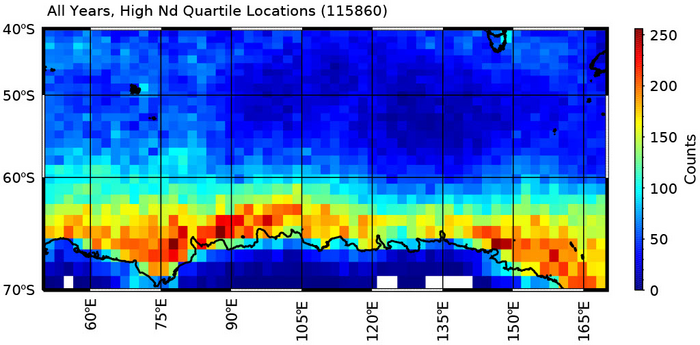The teeming life in the Southern Ocean, which encircles Antarctica, contributes to brightening the clouds that form there, according to a study published today in Atmospheric Chemistry and Physics. The clouds are bright because of their high density of water droplets, due in turn to a chain of atmospheric processes that eventually connects back to the Southern Ocean’s extraordinary phytoplankton productivity.

Credit: Jay Mace/University of Utah
The teeming life in the Southern Ocean, which encircles Antarctica, contributes to brightening the clouds that form there, according to a study published today in Atmospheric Chemistry and Physics. The clouds are bright because of their high density of water droplets, due in turn to a chain of atmospheric processes that eventually connects back to the Southern Ocean’s extraordinary phytoplankton productivity.
The study helps us better understand the natural processes of cloud formation, says Gerald “Jay” Mace, professor of atmospheric sciences at the University of Utah and the study’s lead author.
“We can use that knowledge to improve our understanding of how clouds reflect sunlight globally,” Mace says. “That, in turn, is key to predicting how much the earth warms and how precipitation patterns change.”
Clouds and aerosols
Clouds, with all their dreamlike wispiness or fluffiness, are really only made of water droplets and ice crystals. Those droplets form when water vapor condenses around something in the atmosphere, like an aerosol particle, also called a “cloud condensation nucleus.”
“In most situations, the amount of water available to condense to become a cloud is fixed,” Mace says. “The number of droplets that then form from that fixed amount of water vapor depends upon the number of aerosol particles that are present.”
So, in cases where a region of the atmosphere contains a high number of aerosols, clouds that form have lots of cloud condensation nuclei available. The density of cloud droplets, or number of droplets per volume of the cloud, is also high.
It’s that density of droplets that Mace and his colleagues, including scientists from CSIRO Oceans and Atmosphere in Australia and the University of Tasmania, sought to study in Southern Ocean clouds.
Using satellite data, the researchers examined the properties of clouds in the Southern Ocean during summers between 2014 and 2019. They looked specifically at a region between Madagascar and New Zealand where research vessels and aircraft had traveled in the summer of 2017-2018. The on-the-“ground” data from those research missions supported the satellite observations.
In studying the trends of clouds, the researchers worked to determine where clouds had traveled before arriving in the “airspace” around Antarctica. They noticed a significant difference between two sets of clouds. Clouds with relatively low droplet densities were highly likely to have migrated from more northern latitudes, where salt in the air from spraying ocean water is one of the primary cloud condensation nuclei.
But clouds with relatively high droplet densities were more likely to have originated over the Antarctic continent and to have passed only over the waters of the Southern Ocean. The main difference between the source areas of the two groups of clouds was the plankton productivity in the Southern Ocean.
The plankton, which grow abundantly in the cold, nutrient-rich Antarctic water, release sulfate gases as a part of their metabolism. In the relatively still summer air of the Southern Ocean, those gases can lead to atmospheric chemical reactions that form aerosols.
“The entire circumpolar ocean is highly productive so that there is a massive source of aerosol that finds its way to becoming cloud droplets,” Mace says. “This aerosol is also transported north, and the entire Southern Ocean all the way to the subtropics experiences a seasonal cycle in cloud properties. That seasonal cycle appears to be much larger in the waters around Antarctica causing the clouds to have much higher droplet number and, thereby, be more reflective to sunlight.”
That reflectivity, also called albedo, is significantly higher in the clouds in latitudes closest to Antarctica, southward of about 60° S, than in clouds that formed farther north, the study found.
Studying clean air
The Southern Ocean provides an ideal setting to study natural cloud formation processes, since it’s atmospherically isolated from the rest of the world. That means that it’s free of the aerosols produced by anthropogenic, or human-caused, activity.
“In science, we seek controlled experiments where all extraneous variables are removed from an experiment to isolate the process of interest,” Mace says. “The Southern Ocean is like a controlled experiment where much of the variability due to anthropogenic and continental influence is removed from the experiment.”
The Southern Ocean also plays a key role in the planet’s climate. The productivity of plankton helps the Southern Ocean pull carbon dioxide out of the air and “sequester” it in the oceanic food chain. But the productivity of the ocean is tied to how much sunlight its waters receive – which is tied back to the reflectivity of clouds and the clouds’ droplet densities. It’s a process that plays out in all the world’s oceans, he says, but is more pronounced in the Southern Ocean because of its isolation from other aerosol sources.
“Because cloud droplet number depends upon the biology living in the upper ocean,” Mace says, “we come full circle.”
Mace and his colleagues have more to learn in the Southern Ocean’s natural laboratory, including a recently-announced project based on Tasmania’s Kennaook/Cape Grim.
Find the full study here.
Journal
Atmospheric Chemistry and Physics
DOI
10.5194/acp-23-1677-2023
Method of Research
Observational study
Article Title
Natural marine cloud brightening in the Southern Ocean
Article Publication Date
1-Feb-2023




